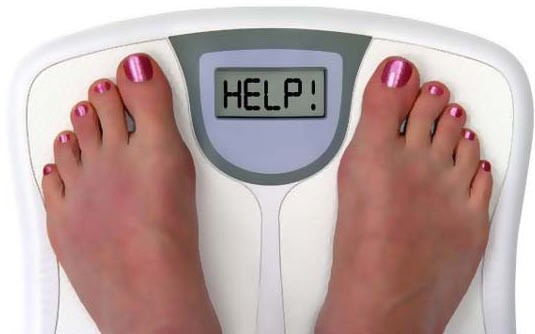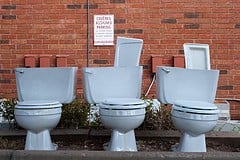You spent your thirties and forties trying to sort out your work/life balance. But suddenly you're in your fifties or sixties, and maintaining physical balance becomes a much more important consideration. Maybe you or someone you know has taken a spill on the stairs or an icy sidewalk. It only takes one balance scare to make you limit your activities and feel suddenly old.
Fitness Over 40
How to Improve Balance: Tips for Baby Boomers and Seniors
Posted by LeeAnn Langdon on Sun, May 13, 2012 @ 06:39 PM
Tags: balance, Baby Boomer, safety, senior exercise, functional fitness
5 Reasons Boomer Women Should Lose Weight SLOWLY
Posted by LeeAnn Langdon on Wed, Apr 18, 2012 @ 02:07 PM
When it comes to weight loss, everyone wants a miraculous quick fix. You've probably heard--and maybe even fallen for--the breathless claims: "Lose a dress size in a week!" "Lose 20 pounds in four weeks!" If you have weight to lose, you're right to get started now, but I always urge my Baby Boomer clients to plan for slow weight loss--much slower than they want--because fast weight loss just comes with too many drawbacks.
Tags: Baby Boomer, exercise, weight loss, bone density, safety, diet
How to Improve Balance: 6 Steps for Seniors
Posted by LeeAnn Langdon on Thu, Dec 08, 2011 @ 07:10 PM
One in every three adults over age 65 fall each year, and 20-30% of those falls will result in moderate to severe injuries. (Source: Centers for Disease Control) Many people who fall develop a fear of falling again that can limit their activity and mobility. To stay mobile and indpendent as you age, maintaining your balance is a must. If your balance is beginning to waver, check out these six steps to improve balance that can help you feel more stable and secure.
Tags: balance, exercise, safety, senior exercise, core exercises
November is American Diabetes Month. The American Diabetes Association estimates that 25.8 million Americans have diabetes. An additional 57 million Americans are estimated to have prediabetes, or higher than normal blood glucose levels.
Tags: Baby Boomer, lifestyle habits, exercise, safety, diet, diabetes, Type 2 diabetes
Putting the Personal in Personal Training: Your First Session
Posted by LeeAnn Langdon on Sun, Nov 13, 2011 @ 12:13 PM
When I meet people for the first time, they're often intrigued by my work as a personal trainer, and if they've never worked with a personal trainer before, they often wonder what makes the experience so special. Some people like working with a personal trainer because it adds an extra measure of accountability, and some like working with a personal trainer because they get more interesting and varied workouts than they would on their own. But what I love about personal training is that it's personal; that is, it's a fitness program designed just for you, your abilities, your needs and your goals.
Tags: exercise, personal training, motivation, safety
4 Tips to Improve Your Stretching and Flexibility Workout
Posted by LeeAnn Langdon on Tue, Sep 27, 2011 @ 07:17 AM
Show of hands: who can no longer touch your toes? How about reaching back to zip up your dress? Low back pain, anyone? If this sounds like you, you could have a problem with decreased flexibility. Flexibility decreases naturally as we age because muscles, tendons and ligaments stiffen and lose elasticity, but you don't have to lose the ability to manage your daily activities. Maintaining and even improving your flexibility is possible at any age with just a few exercises done regularly.
Tags: Baby Boomer, safety, senior exercise, flexibility
Bathroom Safety for Older Adults, or How Squats Can Save Your Life
Posted by LeeAnn Langdon on Mon, Aug 15, 2011 @ 06:13 PM
I just read an article in the New York Times about accidents in the bathroom. According to Centers for Disease Control records, 235,000 adults per year visit an emergency room because of injuries they sustained in the bathroom.
Tags: exercise, safety, strength, senior exercise, functional fitness
Management of Osteoporosis: Five Factors to Prevent Falls
Posted by LeeAnn Langdon on Wed, Jun 29, 2011 @ 03:40 PM
According to the National Osteoporosis Foundation, 10 million Americans have osteoporosis, and an additional 34 million have low bone density. If you’ve been diagnosed with osteopenia or osteoporosis, you know that you have an increased risk of broken bones. Once you’ve been diagnosed, your doctor will give you instructions on how to slow the bone loss with diet, supplements, exercises, and perhaps medication. But you can also manage a number of other factors to prevent dangerous falls.
Tags: osteoporosis, bone density, safety
Exercise for Type 2 Diabetics: 6 Safety Tips
Posted by LeeAnn Langdon on Thu, Jun 16, 2011 @ 11:59 AM
According to the 2011 National Diabetes Fact Sheet, almost 26 million Americans have diabetes. Of those, it's estimated that 90-95% have Type 2 diabetes, the type in which your body becomes resistant to the insulin it produces and can no longer efficiently manage your blood sugar levels.
Tags: safety, Type 2 diabetes










